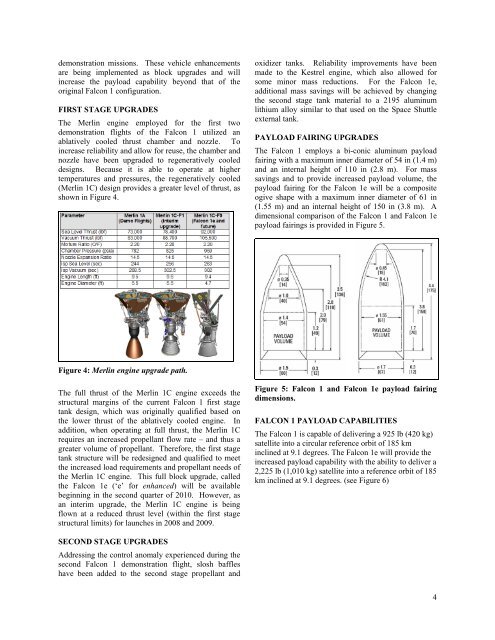The SpaceX Falcon 1 Launch Vehicle Flight 3 - International ...
The SpaceX Falcon 1 Launch Vehicle Flight 3 - International ...
The SpaceX Falcon 1 Launch Vehicle Flight 3 - International ...
You also want an ePaper? Increase the reach of your titles
YUMPU automatically turns print PDFs into web optimized ePapers that Google loves.
demonstration missions. <strong>The</strong>se vehicle enhancements<br />
are being implemented as block upgrades and will<br />
increase the payload capability beyond that of the<br />
original <strong>Falcon</strong> 1 configuration.<br />
FIRST STAGE UPGRADES<br />
<strong>The</strong> Merlin engine employed for the first two<br />
demonstration flights of the <strong>Falcon</strong> 1 utilized an<br />
ablatively cooled thrust chamber and nozzle. To<br />
increase reliability and allow for reuse, the chamber and<br />
nozzle have been upgraded to regeneratively cooled<br />
designs. Because it is able to operate at higher<br />
temperatures and pressures, the regeneratively cooled<br />
(Merlin 1C) design provides a greater level of thrust, as<br />
shown in Figure 4.<br />
Figure 4: Merlin engine upgrade path.<br />
<strong>The</strong> full thrust of the Merlin 1C engine exceeds the<br />
structural margins of the current <strong>Falcon</strong> 1 first stage<br />
tank design, which was originally qualified based on<br />
the lower thrust of the ablatively cooled engine. In<br />
addition, when operating at full thrust, the Merlin 1C<br />
requires an increased propellant flow rate – and thus a<br />
greater volume of propellant. <strong>The</strong>refore, the first stage<br />
tank structure will be redesigned and qualified to meet<br />
the increased load requirements and propellant needs of<br />
the Merlin 1C engine. This full block upgrade, called<br />
the <strong>Falcon</strong> 1e (‘e’ for enhanced) will be available<br />
beginning in the second quarter of 2010. However, as<br />
an interim upgrade, the Merlin 1C engine is being<br />
flown at a reduced thrust level (within the first stage<br />
structural limits) for launches in 2008 and 2009.<br />
SECOND STAGE UPGRADES<br />
Addressing the control anomaly experienced during the<br />
second <strong>Falcon</strong> 1 demonstration flight, slosh baffles<br />
have been added to the second stage propellant and<br />
oxidizer tanks. Reliability improvements have been<br />
made to the Kestrel engine, which also allowed for<br />
some minor mass reductions. For the <strong>Falcon</strong> 1e,<br />
additional mass savings will be achieved by changing<br />
the second stage tank material to a 2195 aluminum<br />
lithium alloy similar to that used on the Space Shuttle<br />
external tank.<br />
PAYLOAD FAIRING UPGRADES<br />
<strong>The</strong> <strong>Falcon</strong> 1 employs a bi-conic aluminum payload<br />
fairing with a maximum inner diameter of 54 in (1.4 m)<br />
and an internal height of 110 in (2.8 m). For mass<br />
savings and to provide increased payload volume, the<br />
payload fairing for the <strong>Falcon</strong> 1e will be a composite<br />
ogive shape with a maximum inner diameter of 61 in<br />
(1.55 m) and an internal height of 150 in (3.8 m). A<br />
dimensional comparison of the <strong>Falcon</strong> 1 and <strong>Falcon</strong> 1e<br />
payload fairings is provided in Figure 5.<br />
Figure 5: <strong>Falcon</strong> 1 and <strong>Falcon</strong> 1e payload fairing<br />
dimensions.<br />
FALCON 1 PAYLOAD CAPABILITIES<br />
<strong>The</strong> <strong>Falcon</strong> 1 is capable of delivering a 925 lb (420 kg)<br />
satellite into a circular reference orbit of 185 km<br />
inclined at 9.1 degrees. <strong>The</strong> <strong>Falcon</strong> 1e will provide the<br />
increased payload capability with the ability to deliver a<br />
2,225 lb (1,010 kg) satellite into a reference orbit of 185<br />
km inclined at 9.1 degrees. (see Figure 6)<br />
4


